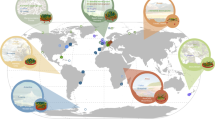Summary
Some properties of community structure are explored using co-evolutionary theory. We consider mathematical models of food webs in which all species in a community adopt foraging behaviours and antipredator behaviours that maximize individual fitness. If the antipredator behaviour of a prey is effective against all its enemies, the number of prey—predator links in a food web must be less than the sum of the numbers of prey and predator species. However, if an increase in a prey's attention to one type of predator decreases its attention to another type of predator, there may be no limit on the number of predator species using a common set of prey species. Predator-specific defence allows a much more complex community structure than non-specific defence. Predator-specific defence more frequently allows a large niche overlap between predators than does non-specific defence. The high connectivity of some fish communities in Lake Tanganyika may be an example of this phenomenon.
Similar content being viewed by others
References
Abrams, P.A. (1982) Functional responses of optimal foragers.Am. Nat. 120, 382–90.
Armstrong, R.A. and McGehee, R. (1980), Competition exclusion.Am. Nat. 115, 151–70.
Cohen, J.E. and Palka, Z.J. (1990) A stochastic theory of community food webs V. Intervality and triangulation in the trophic niche overlap graph.Am. Nat. 135, 435–63.
Cohen, J.E., Briand, F. and Newman, C.M. (1990)Community Food Webs: Data and Theory. Springer-Verlag, Heidelberg.
Endler, J.A. (1986) Defense against predators. InPredator—prey relationships (M.E. Feeder and G.V. Lauder, eds) pp. 109–34. University of Chicago Press, Chicago.
Fretwell, S.D. and Lucas, H.L. (1970) On territorial behaviour and other factors influencing habitat distribution in birds. I. Theoretical development.Acta Biotheor. 19 16–36.
Holt, R.D. (1984) Spatial heterogeneity, indirect interactions, and the coexistence of prey species.Am. Nat. 124, 377–406.
Hori, M. (1991) Feeding relationship among cichlid fishes in Lake Tangayika: effects of intra- and interspecific variations of feeding behavior on their coexistence.Ecol. Int. Bull. 19, 89–101.
Hori, M. (1993) Frequency-dependent natural selection in the handedness of scale-eating cichlid fish.Science 260, 216–19.
Hori, M., Yamaoka, K. and Takamura, K. (1983) Abundance and micro-distribution of cichlid fishes on a rocky shore of Lake Tanganyika.Afr. Study Monogr. 3, 25–38.
Lima, S.L. (1992) Life in a multi-predator environment: some considerations for anti-predator vigilance.Ann. Zool. Fennici 29, 217–26.
Lima, S.L. and Dill, L.M. (1990) Behavioural decisions made under the risk of predation: a review and prospectus.Can. J. Zool. 68, 619–40.
Lloyd, D.G. and Venable, D.L. (1992) Some properties of natural selection with single and multiple constraints.Theor. Popul. Biol. 41, 90–110.
Martinez, N.D. (1991) Artifacts or attributes? Effects on the Little Rock Lake food web.Ecol. Monogr. 61, 367–92.
Matsuda, H., Abrams, P.A. and Hori, M. (1993) The effect of adaptive anti-predator behavior on exploitative competition and mutualism between predators.Oikos 68, 549–59.
Matsuda, H. and Namba, T. (1989) Coevolutionarily stable community structure in a patchy environment.J. Theor. Biol. 136, 229–43.
Matsuda, H. and Namba, T. (1991) Food web graph of a coevolutionarily stable community.Ecology 72, 267–76.
Oaten, A.S. and Murdoch, W. W. (1975) Switching, functional response, and stability in predator-prey systems.Am. Nat. 109, 299–318.
Polis, G.A. (1991) Complex trophic interactions in deserts: an empirical critique of food-web theory.Am. Nat. 138, 123–55.
Tinbergen, L. (1960) The natural control of insects in pine-woods. 1. Factors influencing the intensity of predation by songbirds.Arch. Neel. Zool. 13, 265–343.
Author information
Authors and Affiliations
Rights and permissions
About this article
Cite this article
Matsuda, H., Hori, M. & Abrams, P.A. Effects of predator-specific defence on community complexity. Evol Ecol 8, 628–638 (1994). https://doi.org/10.1007/BF01237846
Issue Date:
DOI: https://doi.org/10.1007/BF01237846




